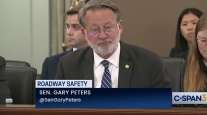Senior Reporter
Senate Transportation Leader Highlights Highway Safety

[Stay on top of transportation news: Get TTNews in your inbox.]
Citing an increase in highway fatalities, the leader of the committee on highway policy in the U.S. Senate pressed for additional resources to remedy the matter.
Sen. Tom Carper (D-Del.), chairman of the Environment and Public Works Committee, called on U.S. Department of Transportation officials to proceed with urgency in tackling a safety crisis on the nation’s roadways.
The committee chairman pointed to recent data from the National Highway Traffic Safety Administration that determined 42,795 individuals died in 2022.
The estimate, unveiled in April, relied on data about people involved in motor vehicle traffic crashes. NHTSA’s latest data was a slight decrease from 2021’s estimate of 42,939.
“Last year, nearly 43,000 people tragically lost their lives on our nation’s roads—the highest number in 16 years,” Carper said during a hearing on June 14 with Shailen Bhatt, administrator of the Federal Highway Administration.
“The U.S. Department of Transportation has taken an important step toward this goal by releasing its National Roadway Safety Strategy, which set a goal of zero fatalities for U.S. roads for the first time,” Carper added. “Still, there is more work that the Federal Highway Administration can and should be doing to prioritize safety. This includes working with states and metropolitan areas to plan streets that are safe for all users and choosing roadway designs that don’t encourage speeding and other unsafe behaviors.”
In acknowledging the chairman’s concerns, Bhatt highlighted programs backed by 2021’s bipartisan infrastructure law designed to promote highway safety. Nearly half of the resources enacted in the $1.2 trillion Infrastructure Investment and Jobs Act, or IIJA, are dedicated for highway and supply chain improvement operations.
To that point, the administrator assured senators his agency is implementing the department’s National Roadway Safety Strategy. The strategy outlook was published in response to NHTSA’s data pertaining to traffic fatalities. The document “outlines the department’s comprehensive approach to significantly reducing serious injuries and deaths on our nation’s highways, roads and streets,” according to USDOT.
“The bipartisan infrastructure law provides resources to change this paradigm, and we are working to make these resources available to recipients as quickly as possible. At the FHWA, our mission is to deliver a world-class transportation system that advances safe, efficient, equitable, and sustainable mobility choices for all while strengthening our nation’s economy,” Bhatt told the senate panel. “Our mission begins and ends with safety.”
Earlier this year, Transportation Secretary Pete Buttigieg cited the department’s safety strategy document in response to NHTSA’s crash figures. “Through our National Roadway Safety Strategy,” said Buttigieg, “we’re strengthening traffic safety across the country, and working toward a day when these preventable tragedies are a thing of the past.”
Meanwhile, at the hearing, ranking member Sen. Shelley Moore Capito (R-W.Va.) highlighted a memorandum from the FHWA unveiled Feb. 24 that affirmed state agencies’ active role in decision-making affairs specific to infrastructure projects.
Want more news? Listen to today's daily briefing above or go here for more info
The latest memo revised FHWA’s guidance from December 2021, which Capito and fellow Republicans interpreted as “fix-it-first” infrastructure policy directives. “Thank you, administrator Bhatt, for issuing a substantially revised policy memorandum that superseded the original one,” Capito told the administrator on June 14. “I appreciate that you recognized the original memorandum diminished the bipartisan accomplishment of this committee and contradicted the statutory text and the clear intent of Congress.”
“When the IIJA was signed into law,” Capito continued, “we promised the American people that the legislation would deliver results by improving our nation’s core transportation infrastructure, and we are starting to see real tangible benefits of that investment.”
According to the Feb. 24 memo from Bhatt, titled, “UPDATE: Policy on Using Bipartisan Infrastructure Law Resources to Build a Better America,” states will determine “which of their projects shall be federally financed by federal aid highway formula dollars. Different states have different needs when it comes to transportation assets that must be reconfigured and modernized, expanded and added, or retired and replaced.”




